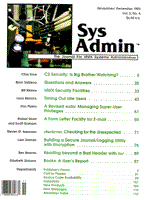
Sidebar: Kill Signals
The kill(1) command sends a signal to a set of processes. You can send the same signal to many processes using a single kill command. Just type kill and the signal number, followed by every process identifier (pid) you want to apply the signal to. If you name the pid but not the signal number, kill uses signal number 15 (terminate). When you want to kill a process and examine a core dump, use signal 3 (quit). You can pause a process with signal number 23 (stop) and continue with signal 25 (continue). If a process simply won't go away no matter how nice you are about it, a signal 9 (kill) eradicates all but the most stubborn processes. Those processes hung up in the kernel that won't go away -- often known as zombie processes -- may not die even when killed with signal 9. The only sure way to eliminate such resource hogs, when all other reasonable attempts fail, is to reboot the system when nobody's looking. To reduce suffering, be sure to wall(1) everybody about the impending reboot. For more information about zombie processes, see Sydney S. Weinstein's article, "Zombie Processes," in the Jan/Feb 1993 Sys Admin (vol. 2, no. 1, p. 49). To review a version of a safe kill program to give your users, see Steven G. Isaacson's article, "sukill: Stopping Unruly Processes," in the Nov/Dec 1992 Sys Admin (vol. 1, no. 4, p. 31). The possible signals differ according to which version of UNIX you're running. Check the signal(5) man page to find out about additional signals your version supports. Some versions of UNIX let you use the name abbreviation instead of the number. Table 3 shows the basic signal set.
|